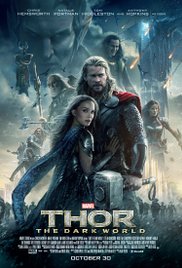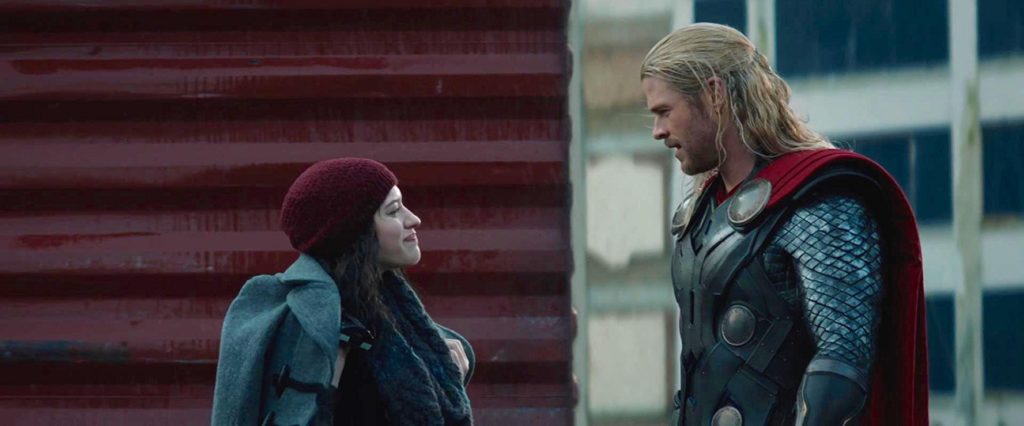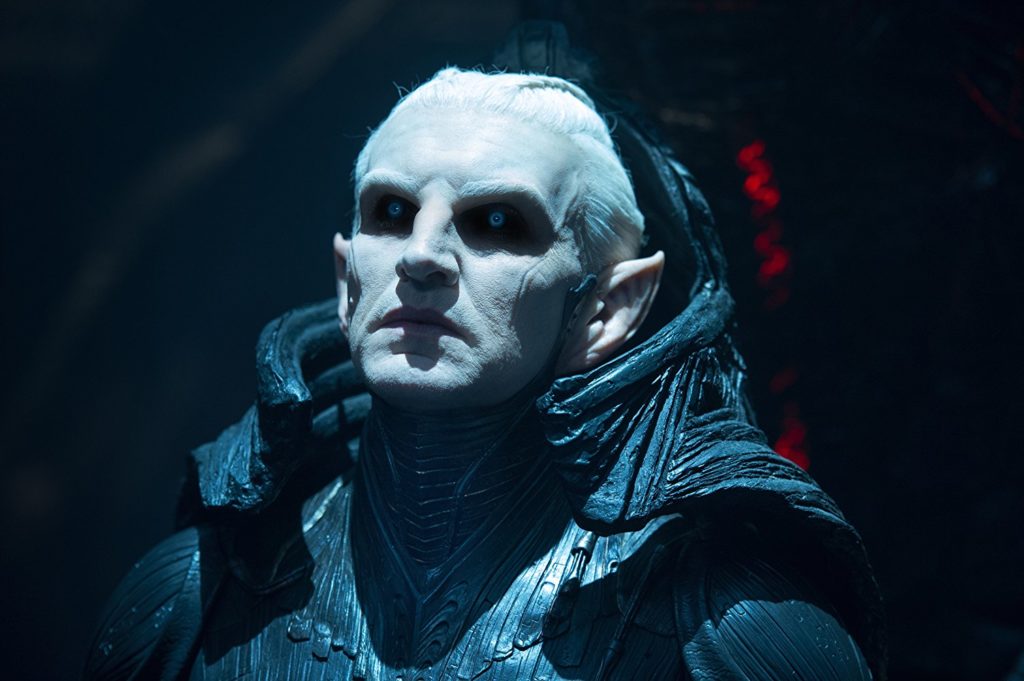Marvel’s Latest is a Marvel Indeed
DIRECTED BY ALAN TAYLOR/2013
 Filmmakers and studios alike, take note: this is how you do a blockbuster movie.
Filmmakers and studios alike, take note: this is how you do a blockbuster movie.
Apparently no one told Marvel that summer was over, because Thor: The Dark World just one-upped the entire blockbuster season—including Marvel’s own Iron Man 3. Heck, I’d go so far as to say The Dark World one-ups last summer’s The Avengers (admittedly one of my least favourite Marvel Studios films). Not only is it bigger than that movie, but it’s better, too—it might even be the best Marvel Studios movie yet.
Of course, even the least of Marvel movies are still pretty great, and the amazing thing is that even if you canmanage to rank them from best-to-worst (hint: it’s harder than it sounds), there isn’t that big of a qualitative variance. Marvel has managed to do what no studio, to my knowledge, has done before—maintain a steady level of excellence, continuity of main cast, and hitherto unparalleled achievements in world-building over the course of what is now eight films and counting (along with several short films called “one-shots”)[1], with four more movies in the pipeline over the next two years of “Phase Two”; not to mention “Phase Three” and beyond. The only shared-universe franchise in my memory that has ever even come close to what Marvel is doing was the Universal Monsters, but that series played fast-and-loose with continuity in a big way (the historical setting was all over the map—practically every other movie was set in a different time period than the last, despite the fact that the same characters kept reappearing over and over again), and replaced the cast every three movies or so.
But Marvel isn’t looking to repeat the mistakes of yesteryear. They’re building the future from the ground up, and they’re not slowing down. Not only that, but TDW proves that they’re just building up more and more creative steam.

Kat Dennings and Chris Hemsworth in THOR: THE DARK WORLD.
2011’s Thor is a favourite of mine, and so it’s fitting that the sequel would continue that winning streak and take it into brand-new territory. That being said, they’re almost incomparable. The first movie is a smaller, intimate film—in some ways more so than most of the other Marvel movies. It’s a movie that is more about relationships than it is about saving the world or fighting evil—even the climactic battle at the end is essentially two brothers hashing out their differences. As such, it’s very much an actor’s showcase. Director Kenneth Branaugh, a veteran of several different Shakespeare adaptations (both in front of and behind the camera), brought the essence of Elizabethan prose to the MCU, which, when coupled by amazing performances by the main cast (in particular Anthony Hopkins and Tom Hiddleston, who came out of nowhere as the film’s MVP), lent the proceedings an extraordinary sense of grown-up gravitas in the midst of the outlandish Jack Kirby trappings.
The Dark World is not that film. Rather than stick to a tried-and-true formula, Marvel has been stretching themselves in Phase Two, showing a willingness to use their characters to tackle different genres (they did this to a certain extent in Phase One as well — Captain America was a WW2 film disguised as a superhero movie). For example, next year’s The Winter Soldier is a political thriller that happens to star Captain America[2]. And while Thor was a family melodrama, The Dark World is a sprawling, universe-spanning science-fantasy epic that cosmically expands the Marvel Cinematic Universe in the way we all expected The Avengers to do last summer, while simultaneously raising the stakes to a whole new level—not only for the MCU as a whole, but for the characters in their personal lives as well. We all braced ourselves for loss when Joss Whedon took the rudder of the MCU as the writer/director of the Avengers films—but who would have thought that it would be the Thor sequel that showed us that no one is safe in this world?

Christopher Eccleston as the villain in THOR: THE DARK WORLD.
Series newcomer Alan Taylor has kicked this franchise into overdrive, while at the same time giving the Nine Realms a more grounded, lived-in look. The experience he brings as a veteran of HBO’s Game of Thrones has given him the ability to make TDW a game changer. Unfolding across multiple worlds and dimensions, it expands the scope of the MCU in big, significant ways, laying the creative groundwork for next year’s Guardians of the Galaxy (Warning! Spoiler area! To read click here!) and the inevitable Avengers 3, demonstrating Marvel’s commitment to playing a long game that pays off big. Not only that, but TDW manages to nail that delicate genre formula that studios have been trying to get right for years—honestly, I haven’t seen anything since the Lord of the Rings trilogy that did what TDW does as well as it does. Which is fitting, because The Dark World is the grand Star Wars/Lord of the Rings mash-up we never even knew we were waiting for; but I am so thankful that we got it.
Imagine a version of Krull that exists in the Best of all Possible Worlds, with a huge budget and A-list talent behind it, wedded to the name recognition of a first string Superhero. Minus the questing aspect, that’s The Dark World. It’s the movie that Star Trek, The Hobbit, and Man of Steel all wish they could be. And speaking of the latter, director Zack Snyder should take note—Taylor demonstrates that it is possible to stage an awesome, super-powered throw-down between two godlike beings without massacring thousands of innocent bystanders in the process. And as for General Zod—well, he ain’t got nothing on Malekith the Accursed, whose army of Dark Elves makes the Chitauri look like Federation battle droids. Christopher Eccleston is menacing and brooding as the head baddie, an ancient warrior from before the dawn of time who’s nursing a grudge just as old, and nothing short of universal vengeance will satisfy that itch. He flies massive, thundering spacecraft, and his right-hand-man, Kurse (Adewale Akinnuoye-Agbaje), might just be the most awesome supervillain henchmen I’m ever seen. In any other movie, he’d be the main heavy—here he’s just the muscle.
Malekith’s quest for a universe-destroying MacGuffin is at the center of the story, and like the best MacGuffins (the Ark of the Covenant from Raiders; the briefcase from Pulp Fiction), it facilitates the action of the film in the best of ways, giving us a thrilling adventure that includes air chases, starships, monsters, a prison break, double-and-triple crosses, fake-outs, and much more. It also allows for a reversal of the Thunder god-out-of-water hi-jinx from the first movie, bringing Natalie Portman’s Jane Foster to Asgard this time around, and picking up the romantic subplot from the first movie. There’s a few other delightful subplots to be found, involving secondary and tertiary characters, but I won’t spoil them here. As always, make sure to stay all the way to the end of the credits (you’ll miss the conclusion of one of those subplots if you don’t), and keep your eyes open for a few other wonderful surprises. But perhaps the biggest surprise of all is how Thor: The Dark World, the second, third, and/or eighth movie (depending on your definition) in a superhero(es) franchise, flagrantly defies the law of diminishing returns and takes the MCU to the next level.

